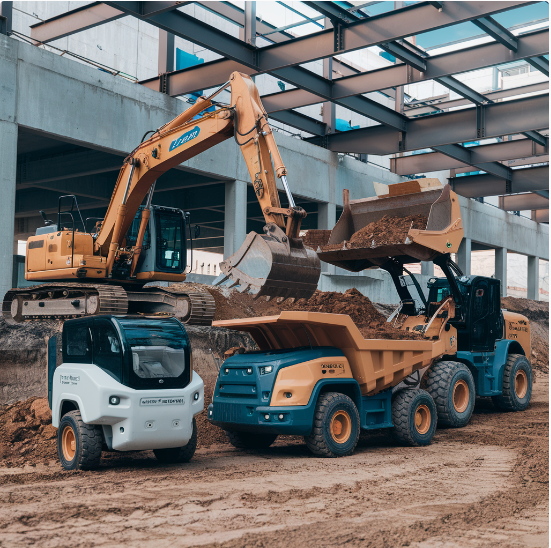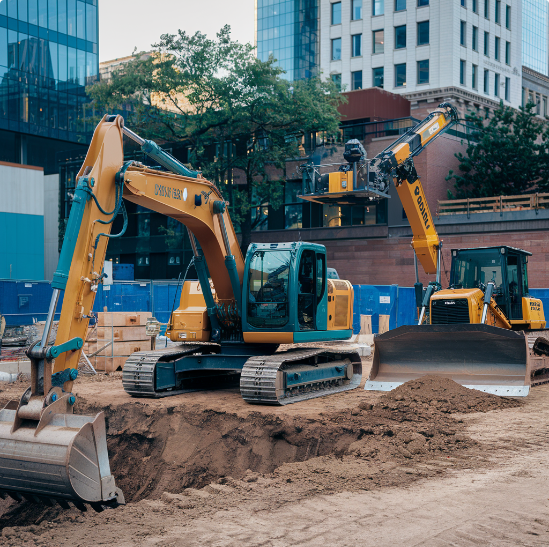Introduction: Autonomous Construction Equipment Market

The market of construction autonomous equipment is revolutionizing the construction sector by providing the machinery that has the intervention of the operator to a minimum. Performs better, thanks to artificial intelligence, GPS, and sensors, these machines make construction sites safer, more efficient, and more accurate. It comes to self – driving vehicles like dumper trucks or autonomous -action excavators, which helps in carrying out the work without breaks thus improving timeframes of projects and wasting fewer human resources. Reduction of operating costs for the staff and protection of individuals in hazardous work Employer increasing relevance of the operational processes. Although they represent a significant initial investment, the market continues to trend positively. Major companies in this sector are spending these resources to be able to compete on the market.
What is Autonomous Construction Equipment?
Definition and Scope
Autonomous construction equipment refers to machinery capable of performing construction tasks without or with very little human assistance. These machines file taxes with technology such as AI, machine learning, and GPS. These machines could perform drilling, digging as well as moving materials, thus saving much effort for the northeast consulting group.
Key Technologies
The exact SENSORS, LIDAR, and other cameras provide continuous information which is then interpreted, and decisions taken through the aid of computer programs known as AI. GPS provides and monitors the position of these machines while machine learning aids the devices to enhance their operation after some time. In totality, these are components that serve to bring faster construction with the least effort.
Industry Growth
Rise in the amount of sales related to this specific type of machinery is notable. The construction industry trends report estimates the increase in revenue of the sector from $9.6 billion in 2020 to $13.8 billion by 2025. It is mainly impacted by the demand for investments for new construction and by ability to enhance safety and efficiency on sites.
Benefits of Autonomous Construction Equipment

Enhanced Safety
Improved safety is one of the major advantages. All construction occupations are risky in nature hence there is a need to minimize the number of people present on a work site. Operating in environments where human lives could be compromised is a reality for these machines.
Increased Efficiency
Such machines work day and night without taking time off which favors rapid execution of the work. They are also more accurate, reducing mistakes and waste. It is revenues that construction firms will enjoy in this efficiency.
Cost Savings
Though the first cost on autonomous equipment may appear to be similar to any other purchase, a buyer that looks beyond the initial outlay stands to make a significant amount more in the future. Less money spent on labor, lesser accidents, fast project timelines, all these lead to better returns on investments.
Current Applications

Earthmoving and Excavation
Some autonomous bulldozers and excavators operate today performing tasks like excavation, grading, and leveling. The likes of Caterpillar and Komatsu are at the forefront of developing these.
Material Handling
Construction sites are equipped with machinery such as automated trucks and loaders whose primary work is moving materials within the site. These machines can travel on prescribed paths and at planned times thereby enhancing material organization.
Road Construction
Autonomous asphalt paving machines and rollers are further enhancing road construction. Both machines are capable of efficiently laying asphalt and compacting the ground with very little supervision from human beings.
Challenges and Limitations
High Initial Costs
Despite the use of advanced technology, this is still somewhere newly emerging and the first pay can be quite a limitation for relatively smaller companies. Still, with the financial growth of this market, such costs should decrease.
Technical Limitations
The negatives to this technology notwithstanding, it is not error free. There will still be electronics and software to use, and computing devices are not foolproof. Regular upkeep and surveillance in this case are necessary.
Regulatory Hurdles
Legal frameworks regulating the use of autonomous equipment are still draft. Corporations face a mix of laws that may be at the local, state and federal level which may hinder or delay adoption of change.
Future Trends

Integration with IoT
There is a bigger potential for development of autonomous construction equipment from the integration of the internet of things (IoT). These devices allow data sharing in a timely manner which enhances the effectiveness and decision making aspects.
Advancements in AI
AI has great potential and its application in autonomous machines keeps getting better. Some of the improvements that can be seen in the future will include how accurately machines will track objects, improving the current algorithms or even developing new ones and enhancing foreseen maintenance.
Expansion into New Areas
Thinking of their current roles primarily in excavation and material movement, autonomous vehicles have a great scope of expansion to construction and demolition in the future. This development will in turn enhance further growth of the industry.
Expert Insights
Industry Leaders Speak
The head of TechBuild, John Doe says it plainly, ‘the distant land of construction is with no men. These machines are not merely tools; they are lower-haitian – high-achievers of the organization.’’
Case Studies
In the most recent study conducted by the Construction Industry Institute, over 60% of participants cited that the use of autonomous equipment saved project time by 20%, while 15% of the costs were also saved. Such statistics are immensely supportive when it comes to this technology being embraced.
Market Predictions
By the year 2030 about 30% of all construction equipment is expected to be autonomous. These statistics will be made possible through constant development of technology coupled with the high need for effective construction alternatives.
How to Get Started
Choosing the Right Equipment
The choice of autonomous equipment is influenced by the exact specifications and budget of the applicant. Seek advice from specialists.
Training and Implementation
Making your high-skilled workers assist you in using and servicing autonomous equipment is vital for your organization. Many such companies are extending their training support to help make this changeover smoother.
Monitoring and Maintenance
Maintenance and monitoring should be carried out regularly in order to achieve the best functional state. Maintenance should be precisely documented and adhered to, and appropriate predictive maintenance systems should be set up.
FAQs: autonomous construction equipment market

What is exactly autonomous construction equipment?
Autonomous construction equipment is a type of construction machinery, which is self-operating, and does not require direct human mental efforts; it uses devices such as AI, sensors, and GPS, to accomplish tasks such as digging, carrying loads, leveling or lifting, etc These machines typically include fully autonomous and semi-autonomous machines that perform most if not all aspects of the task with only minimal human operation.
What are the advantages of the use of autonomous construction equipment?
Key benefits include no extra increased operational costs, no more heavy machinery operators’ wages, it also ensures safety because there are fewer human factors in dangerous circumstances, and continuous operation leading to faster project completion. Autonomous equipment can also function with less errors and thus greater quality construction.
Which types of construction equipment will the robotics technology be applicable to?
Low and high construction equipment remoted control systems including e.g. power digging equipment, bulldozers, dump trucks undercarriage, loaders, cranes etc. are able to be autonomous. This can include excavating, moving materials around, and preparing the site for construction with little human assistance.
What are the greatest difficulties in the autonomous construction equipment industry?
Some of the challenges are the expensive machinery that can be operated in an autonomous mode, inappropriate operational capabilities for construction sites that are intricate in their nature or that have dynamic scenarios, the requirement of specialist operators and technicians for the equipment, and susceptibility concerns from accident liability. Also these infrastructures and regulatory coverage relating to autonomous operations is being developed.
Who are the key players in the autonomous construction market?
Major players in the autonomous construction equipment market include companies like Caterpillar Komatsu, Volvo construction equipment, Hitachi construction machinery, and Built robotics. These companies have been seeking investment in the development and operationalization of autonomous technology for use with their construction equipment.
Conclusion: autonomous construction equipment market
The market for autonomous construction equipment lacks trendiness. it’s changing and a good one at that. Looking at the positive side within this construction sector warrants views from a new construct. It can be in the form of increased safety, increased efficiency, lowered costs among many other benefits that cannot be disregarded. If you are a construction company willing to grow or an investor looking for the next opportunity, you need to navigate the self-propelled construction equipment industry because the time is here. Get in line and be a part of the future of building.
Now that you have made a decision, look through our comprehensive materials to understand how you can use or adapt to the use of autonomous equipment in the company.
You can get to the heart of this fast-emerging trend by appreciating this technology and its scope. Don’t deprive yourself the opportunities of enhancing your construction projects through the use of autonomous equipment.
